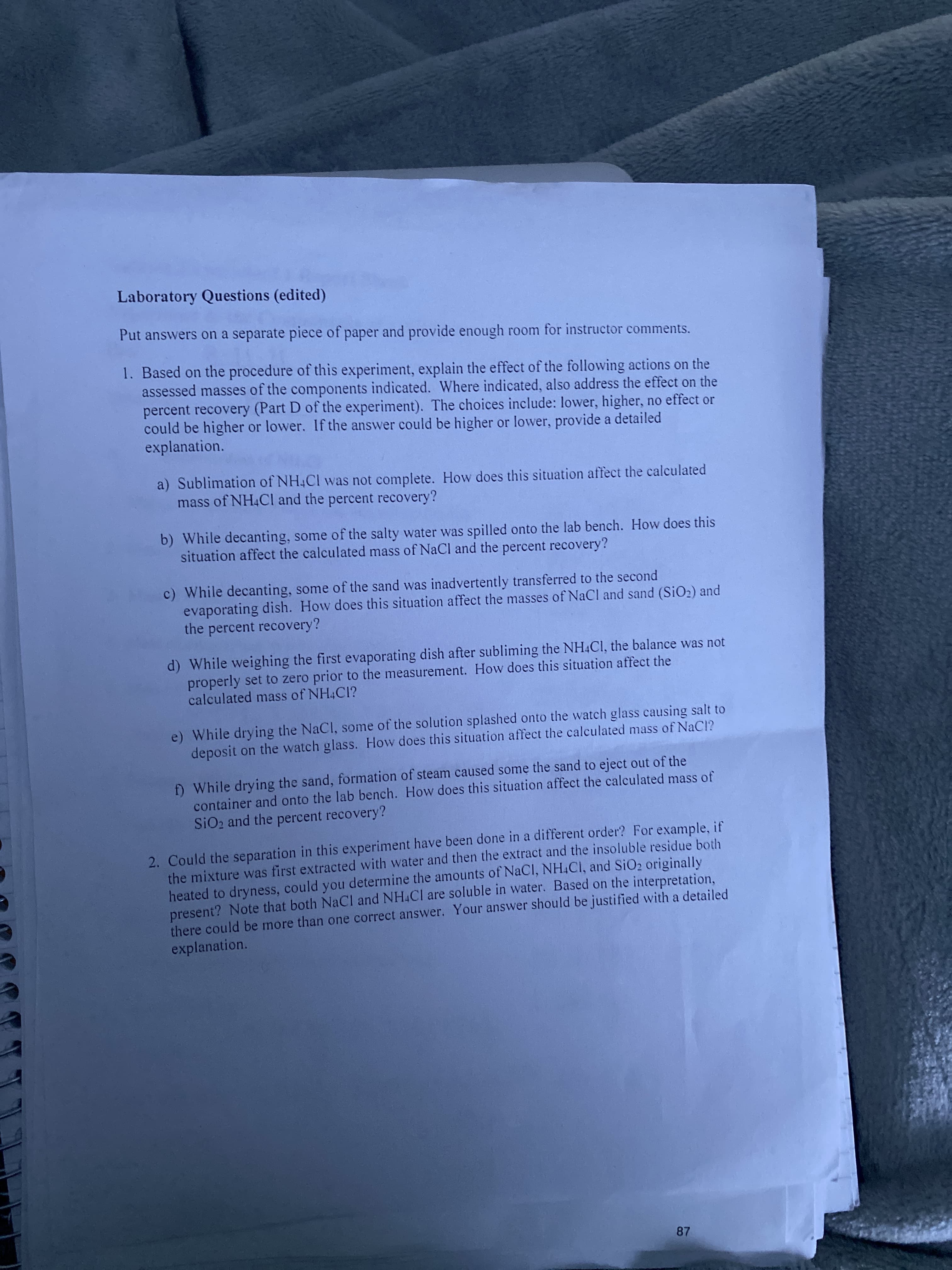Laboratory Questions (edited) Put answers on a separate piece of paper and provide enough room for instructor comments. 1. Based on the procedure of this experiment, explain the effect of the following actions on the assessed masses of the components indicated. Where indicated, also address the effect on the percent recovery (Part D of the experiment). The choices include: lower, higher, no effect or could be higher or lower. If the answer could be higher or lower, provide a detailed explanation. a) Sublimation of NH4CI was not complete. How does this situation affect the calculated mass of NH4CI and the percent recovery? b) While decanting, some of the salty water was spilled onto the lab bench. How does this situation affect the calculated mass of NaCl and the percent recovery? c) While decanting, some of the sand was inadvertently transferred to the second evaporating dish. How does this situation affect the masses of NaCl and sand (SiO2) and the percent recovery? noo /as not
Laboratory Questions (edited) Put answers on a separate piece of paper and provide enough room for instructor comments. 1. Based on the procedure of this experiment, explain the effect of the following actions on the assessed masses of the components indicated. Where indicated, also address the effect on the percent recovery (Part D of the experiment). The choices include: lower, higher, no effect or could be higher or lower. If the answer could be higher or lower, provide a detailed explanation. a) Sublimation of NH4CI was not complete. How does this situation affect the calculated mass of NH4CI and the percent recovery? b) While decanting, some of the salty water was spilled onto the lab bench. How does this situation affect the calculated mass of NaCl and the percent recovery? c) While decanting, some of the sand was inadvertently transferred to the second evaporating dish. How does this situation affect the masses of NaCl and sand (SiO2) and the percent recovery? noo /as not
Organic Chemistry: A Guided Inquiry
2nd Edition
ISBN:9780618974122
Author:Andrei Straumanis
Publisher:Andrei Straumanis
Chapter5: Resonance
Section: Chapter Questions
Problem 18E
Related questions
Question

Transcribed Image Text:Laboratory Questions (edited)
Put answers on a separate piece of paper and provide enough room for instructor comments.
1. Based on the procedure of this experiment, explain the effect of the following actions on the
assessed masses of the components indicated. Where indicated, also address the effect on the
percent recovery (Part D of the experiment). The choices include: lower, higher, no effect or
could be higher or lower. If the answer could be higher or lower, provide a detailed
explanation.
a) Sublimation of NH4CI was not complete. How does this situation affect the calculated
mass of NH4CI and the percent recovery?
b) While decanting, some of the salty water was spilled onto the lab bench. How does this
situation affect the calculated mass of NaCl and the percent recovery?
c) While decanting, some of the sand was inadvertently transferred to the second
evaporating dish. How does this situation affect the masses of NaCl and sand (SiO2) and
the percent recovery?
d) While weighing the first evaporating dish after subliming the NH4CI, the balance was not
properly set to zero prior to the measurement. How does this situation affect the
calculated mass of NH4CI?
e) While drying the NaCl, some of the solution splashed onto the watch glass causing salt to
deposit on the watch glass. How does this situation affect the calculated mass of NaCl?
D While drying the sand, formation of steam caused some the sand to eject out of the
container and onto the lab bench. How does this situation affect the calculated mass of
SiO2 and the percent recovery?
2. Could the separation in this experiment have been done in a different order? For example, if
the mixture was first extracted with water and then the extract and the insoluble residue both
heated to dryness, could you determine the amounts of NaCl, NH.Cl, and SiO2 originally
present? Note that both NaCI and NH4CI are soluble in water. Based on the interpretation,
there could be more than one correct answer. Your answer should be justified with a detailed
explanation.
87
Expert Solution
This question has been solved!
Explore an expertly crafted, step-by-step solution for a thorough understanding of key concepts.
This is a popular solution!
Trending now
This is a popular solution!
Step by step
Solved in 2 steps

Recommended textbooks for you

Organic Chemistry: A Guided Inquiry
Chemistry
ISBN:
9780618974122
Author:
Andrei Straumanis
Publisher:
Cengage Learning

Organic Chemistry: A Guided Inquiry
Chemistry
ISBN:
9780618974122
Author:
Andrei Straumanis
Publisher:
Cengage Learning